Articles
- Page Path
- HOME > J Korean Acad Nurs > Volume 39(4); 2009 > Article
-
Original Article
- Effects of a Palliative Care Program based on Home Care Nursing
- Moon Sook Hwang, Ho Sihn Ryu
-
Journal of Korean Academy of Nursing 2009;39(4):528-538.
DOI: https://doi.org/10.4040/jkan.2009.39.4.528
Published online: August 31, 2009
1Clinical Professor, Graduate School of Clinical Nursing Science, Sungkyunkwan University, Research Institute for Clinical Nursing Science, Samsung Medical Center, Seoul, Korea.
2Professor, College of Nursing, Korea University, Seoul, Korea.
- Address reprint requests to: Hwang, Moon Sook. Graduate School of Clinical Nursing Science, Sungkyunkwan University, Research Institute for Clinical Nursing Science, Samsung Medical Center, 50 Irwon-dong, Gangnam-gu, Seoul 135-710, Korea. Tel: 82-2-3410-6430, Fax: 82-2-3410-6616, msyellow45@hanmail.net
Copyright © 2009 Korean Society of Nursing Science
Abstract
-
Purpose
- This study was done to develop and test a palliative care program based on home care nursing.
-
Methods
- A quasi-experimental design was employed. Changes in the variables were evaluated to test effects of the developed program. Participants were patients with terminal cancer and their families receiving home care nursing from six hospitals (experimental group: 24 and control group: 22). Data collection was conducted from February to October, 2006. Chi-square test, Fisher's exact test, t-test, Mann-Whitney U test and repeated measures ANOVA were used to analyse the data.
-
Results
- Hypothesis 1, the experimental group receiving this program will experience less pain (severe, average, weak pain) than the control group, was supported. Hypothesis 2, the experimental group will have less symptom experience than the control group, was supported. Hypothesis 3, the experimental group will have higher QOL than the control group, was supported and the last hypothesis 4, family burden in the experimental group will be less than the control group, was supported.
-
Conclusion
- The home care nursing based palliative program developed in this study was found to be an effective program to reduce patient pain and symptom experience, to improve patient QOL and to decrease family burden.
- 1. Aaronson NK, Ahmedzai S, Bergman B, Bullinger M, Cull A, Duez NJ, et al. The European organization for research and treatment of cancer QLQ-C30: A quality of life instrument for use in international clinical trials in oncology. Journal of the National Cancer Institute. 1993;85:365–376.ArticlePubMed
- 2. Ahn EJ. A study on burden and burnout of family care-givers for caring of terminal cancer patients. 2004;Gwangju, Chonnam National University. Unpublished master's thesis.
- 3. American Pain Society. Quality improvement guidelines for the treatment of acute pain and cancer pain. Journal of the American Medical Association. 1995;274:1874–1880.ArticlePubMed
- 4. Bostrom B, Hinic H, Lundberg D, Fridlund B. Pain and health-related quality of life among cancer patients in final stage of life: A comparison between two palliative care teams. Journal of Nursing Management. 2003;11:189–196.ArticlePubMed
- 5. Choi ES. Experiences of facility caregivers with terminal cancer patients. 2006;Seoul, Seoul National University. Unpublished doctoral dissertation.
- 6. Cohen J. Statistical power analysis for the behavioral science. 1988;2nd ed. Hillsdale, NJ, Lawrence Erlbaum Association Pub.
- 7. Harrington V, Lackey NR, Gates MF. Needs of caregivers of clinic and hospice cancer patients. Cancer Nursing. 1996;19:118–125.ArticlePubMed
- 8. Kang KA, Kim SJ, Kim YS. The need for hospice care in families of patients with cancer. Journal of Korean Community Nursing. 2004;15:639–647.
- 9. Kim TS, Yang BG, Jeong EK, Park NR, Lee YS, Lee YS, et al. Need assessment of home based cancer patients. Korean Journal of Hospice and Palliative Care. 1999;2:36–45.
- 10. Kim YO. Effects of home care services on discomfort in patients with cancer and on caregiver burden. 2003;Seoul, Yonsei University. Unpublished master's thesis.
- 11. Statistics on mortality causes. Korean National Statistical Office. 2007;10 21 Retrieved April 27, 2009. from http://www. kosis.krhttp://www. kosis.kr.
- 12. Kwon IK. Effects of education on pain management provided to cancer patients and medical personnel. 1999;Seoul, Seoul National University. Unpublished doctoral dissertation.
- 13. Kwon IK, Hwang MS, Kim JH. Effects of pain management education on pain of the terminal cancer patients at home. Journal of Korean Oncology Nursing. 2002;2:36–49.
- 14. Larson PJ, Uchinuno A, Izumi S, Kawano A, Takemoto A, Shigeno A, et al. An integrated approach to symptom management. Nursing and Health Science. 1999;1:203–210.Article
- 15. Lee JS. The development and evaluation of the caregiving stress management program for families of terminal cancer patients. 2006;Seoul, Korea University. Unpublished doctoral dissertation.
- 16. Lee KY, Song KY. A study on the degree of burden and depression in family caregivers of patients with stroke. Journal of Korean Academy of Nursing. 1996;26:853–867.ArticlePDF
- 17. Lee SW, Kim HS, Kim SY, Hong YS, Kim YK. Patient satisfaction with cancer pain management. Korean Journal of Hospice and Palliative Care. 2003;6:22–33.
- 18. Lee SW, Lee YO, An HS, Huh DS, Kim DS, Kim HS, et al. The national hospice care service development in Korea. Korean Nurses. 1997;36(3):49–67.
- 19. Lenz ER, Pugh LC, Milligan RA, Gift A, Suppe F. The middle-range theory of unpleasant symptoms: An update. Advances in Nursing Science. 1997;19(3):14–27.ArticlePubMed
- 20. National Hospice Organization. Hospice operations manual. 1997;Dubuque, Kendall/Hunt Publishing Company.
- 21. Ryu SY. The effects of hospice care on QOL in terminal cancer patients. 2001;Seoul, Yonsei University. Unpublished master's thesis.
- 22. Sparks SM. Harris MD. Using the internet for home health and hospice care. In: Handbook of home health care administration. 1997;Gaithersburg, MD, Aspen Publishers Inc. 892–897.
- 23. Suh MH, Oh KS. A survey of well-being in caregivers caring for chronically ill family members. Journal of Korean Academy of Nursing. 1993;23:467–486.
- 24. Sun JJ. Change in pain and quality of life of terminal cancer patients through hospice home care. 2003;Gwangju, Chonnam National University. Unpublished master's thesis.
- 25. Woods NF, Yates BC, Primomo J. Supporting families during chronic illness. Image-Journal of Nursing Scholarship. 1989;21:46–50.Article
- 26. Yun GE. Development of quality of life measurement for patients with terminal illness. 1998;Seoul, Yonsei University. Unpublished doctoral dissertation.
- 27. Yun MO. Development and effect of spiritual nursing program for the terminal cancer patients. 2004;Daegu, Keimyung University. Unpublished doctoral dissertation.
- 28. Yun YH, Park YS, Lee ES, Bang SM, Heo DS, Park SY, et al. Validation of the Korean version of the EORTC QLQ-C30. Quality Life Research. 2004;13:763–768.
- 29. Zarit SH, Reever KE, Bach-Peterson J. Relatives of the impaired elderly: Correlates of feelings of burden. Gerontologist. 1980;20:649–655.ArticlePubMed
REFERENCES
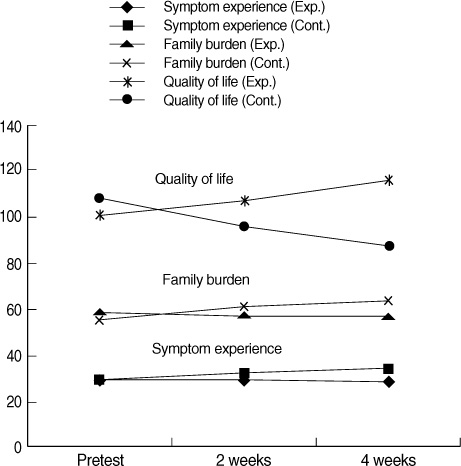
Figure & Data
REFERENCES
Citations

- The Effect of Hospice Patients' Pain, Anxiety, Depression, Perception of Dignity, and Spiritual Well-Being on their Attitudes toward Dignified Death
Yun Sil Ahn, Pok Ja Oh
Korean Journal of Adult Nursing.2021; 33(3): 212. CrossRef - Cost-Effectiveness Analysis of Hospice-Palliative Care for Adults with Terminal Cancer in South Korea
Yeong Jun Ju, Woorim Kim, Yoon Soo Choy, Joo Eun Lee, Sang Ah Lee, Jieun Jang, Eun-Cheol Park
The Korean Journal of Medicine.2019; 94(3): 273. CrossRef - Effects of Integrated Palliative Care Intervention on Quality of Life in Terminal Cancer Patients: A Meta-analysis
Kae Hwa Jo, Ae Ran Park, Jin Ju Lee
The Korean Journal of Hospice and Palliative Care.2015; 18(2): 136. CrossRef - Effectiveness and cost-effectiveness of home palliative care services for adults with advanced illness and their caregivers
Barbara Gomes, Natalia Calanzani, Vito Curiale, Paul McCrone, Irene J Higginson, Maja de Brito
Cochrane Database of Systematic Reviews.2013;[Epub] CrossRef - Analysis of Use of Government Support for Palliative Care Units in Korea
Hyo Young Kim, Eun Sil Yoo, Yeol Kim, Kyoung Ae Kong, Hye Young Song, Jin Young Choi
The Korean Journal of Hospice and Palliative Care.2011; 14(4): 212. CrossRef - Development and Evaluation of 「Hospice Smart Patient」 Service Program
Chai-Soon Park, Yang-Sook Yoo, Dong-Won Choi, Hyun-Jeong Park, Ji-In Kim
Journal of Korean Academy of Nursing.2011; 41(1): 9. CrossRef
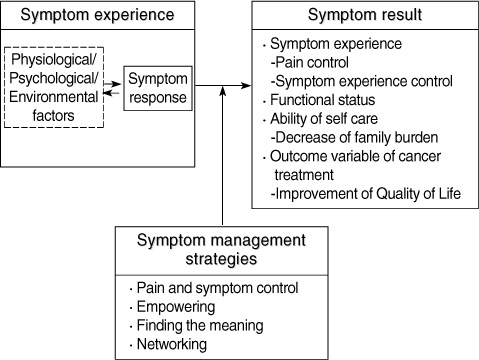

Figure 1
Figure 2
The Components and Contents for Palliative Care Program
Homogeneity Test for General Characteristics and Disease related Characteristics (N=46)
†Fisher's exact test.
Exp.=experimental group; Cont.=control group.
Differences of the Pain between Experimental and Control groups (N=46)
Exp.=experimental group; Cont.=control group.
Symptom Experience, Quality of Life and Family Burden between Experimental and Control groups according to the Time Intervals (N=46)
Exp.=experimental group; Cont.=control group.
†Fisher's exact test. Exp.=experimental group; Cont.=control group.
Exp.=experimental group; Cont.=control group.
Exp.=experimental group; Cont.=control group.
 KSNS
KSNS
 E-SUBMISSION
E-SUBMISSION

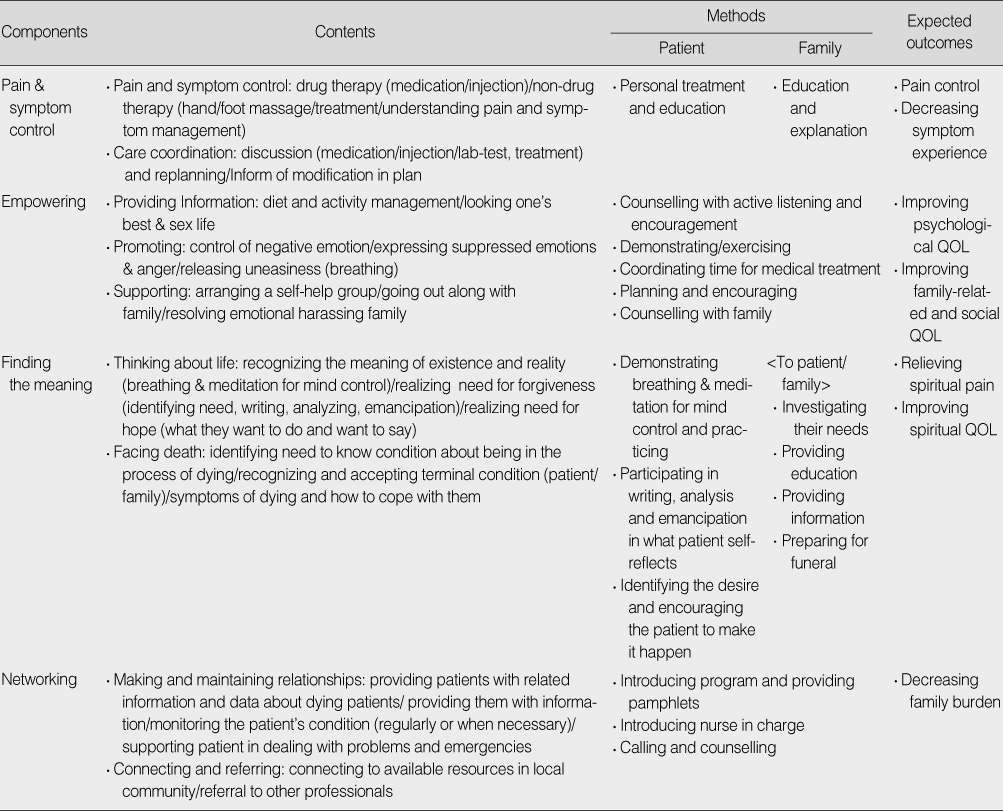
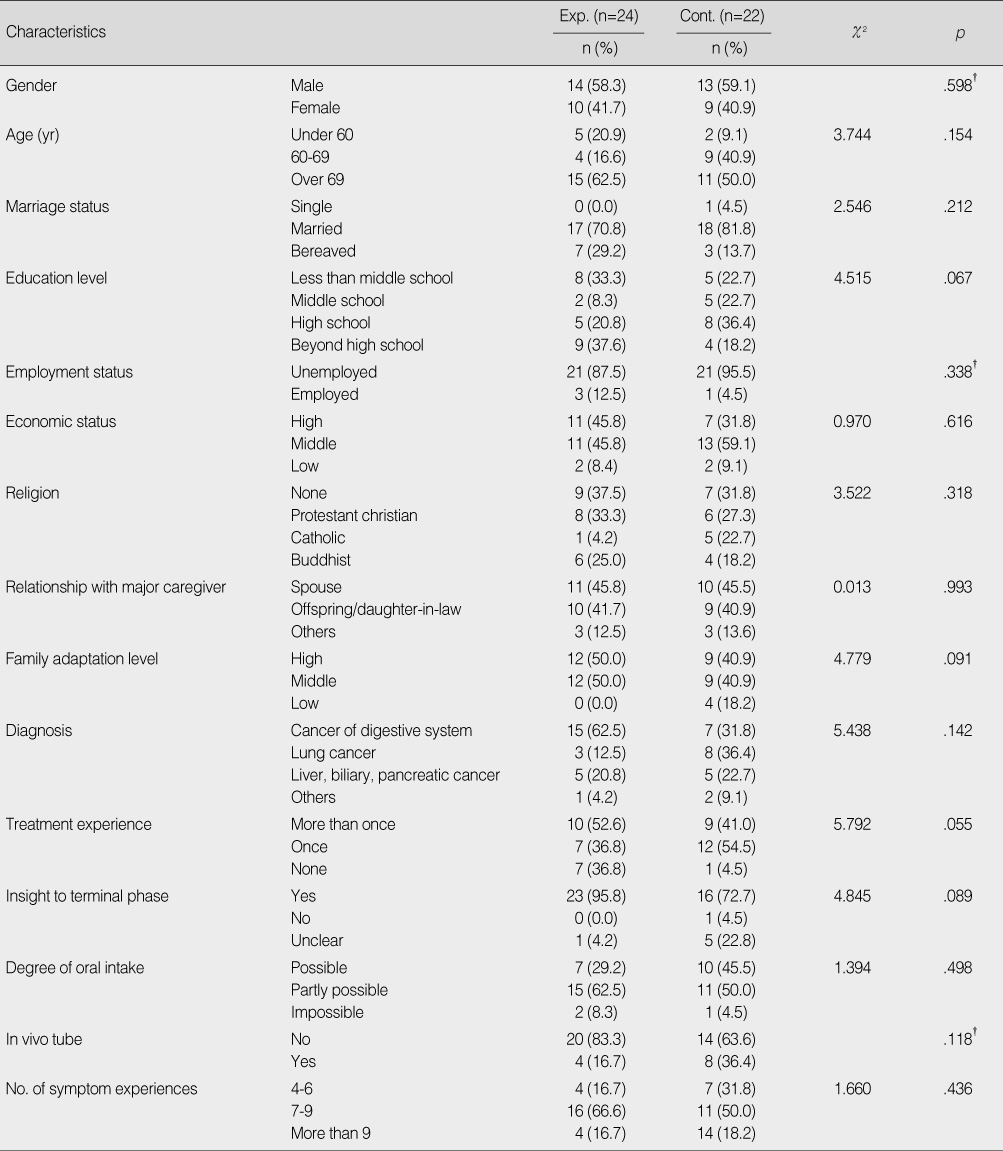
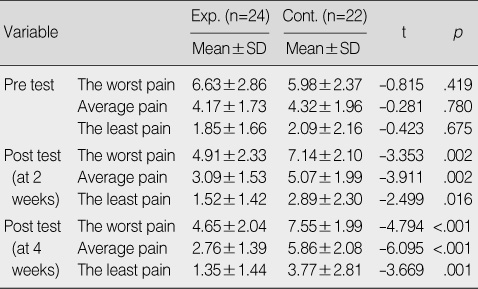

 Cite
Cite

